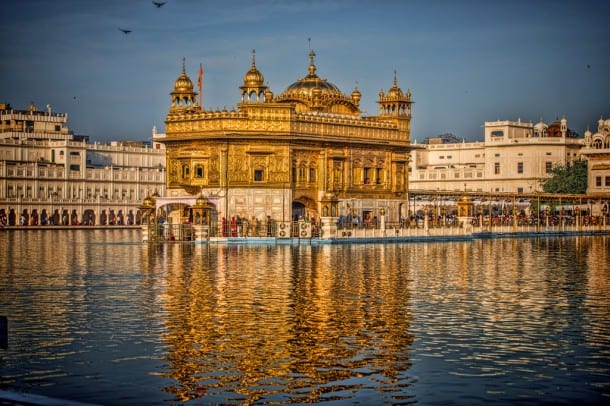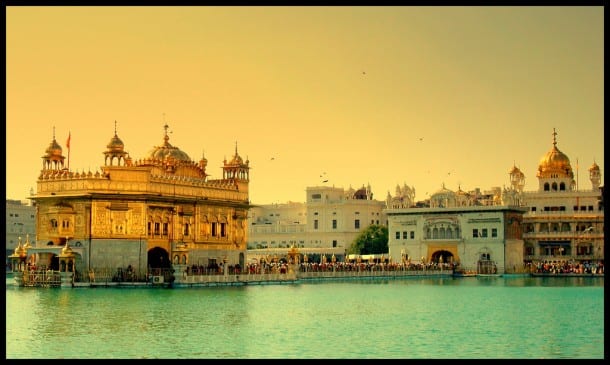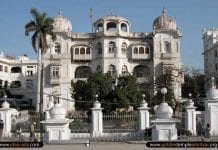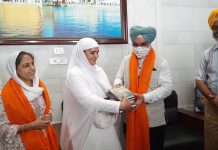The Golden Gurdwara at Amritsar is the focal point of a faith which by the simplicity of its belief, its exalted moral principles, and sustained heroism, has won an honored place in the history of Punjab. Sikhism the youngest of world’s religions, derives its inspiration from a living spiritual and historical tradition. The vivid heritage has made a deep impact on the life of the people. Sikhs, a small community of nearly 24 million,are a unique people in the religious civilization of the world. Practical and progressive in their outlook, they are deeply attached to their faith. Religion is a vital impulse for them, and it is the mainspring of their national characteristics, and endeavors. Sikhs are commonly known as soldiers, or farmers. In a foreign land, a Sikh may be hailed as a representative of the Indian princely class, such in his physical bearing and stature. Tribute has not been lacking for Sikhs’ picturesque beards and flamboyant headgear, and for their qualities of courage and adventure, but appreciation for the underlying sources of their inspiration and traditions has generally been rather limited.



Sikhs are a deeply devoted people, and faith is an essential characteristic of their nature. An immense reserve of spiritual energy has been their strongest asset in many crisis during their 500 year old history. When the requested partition of India took place in 1947, nearly half the nation was reduced to a homeless, landless refugee population, Sikhs showed great recuperative power and fortitude. The Radcliff Line, demarking the two new sovereign states of India and Pakistan from each other, ran through the middle of the Sikh population dividing it into two almost equal halves. Migrating from what then became the West Punjab Province of Pakistan, the uprooted community re-established itself gradually but securely in the life of their new country. Their firm, unshakable faith was their sole standby in a most trying situation. Rather than produce any truculent fanatical spirit, their religious zeal resulted in shining deeds of noble heroism and sacrifice. For, at the root of their history lay simple virtues such as tolerance, humility, and service, sedulously inculcated when preached by their Gurus, or prophetic teachers.
The foundation of the Golden Gurdwara was laid at the request of the fifth Sikh Guru by one of his Muslim followers. The Guru built four doors, one on each side, to distinguish the holy building from the traditional India Temples with only one door. His object was to emphasize that Sikh place of worship was open to all, irrespective of difference of caste, or creed. In Sikhism, the holy Scriptures are hymns written by several Sikh gurus as well as pious men from among both Hindus and Muslims. There are also verses by the Shudras, who by orthodox Indian standards, were neither allowed to hear, nor utter the sacred word. The fifth Guru who compiled the Sikh Holy Scriptures, broke through these narrow divisions and gave an honored place to the writings of saints from other communities besides his own and those his four spiritual predecessors. The resultant Granth, or the sacred volume, is unique among world’s religious books for its mystic ardor and universality.
When, after a long period of desperate and bold struggles against religious persecution, Sikhs succeeded, at the beginning of the 19th century, in establishing their own rule under the leadership of Maharaja Ranjit Singh. They readily forgave their persecutors and treated them with utmost tolerance and friendliness. Ranjit Singh the sovereign Sikh of the Punjab, was a ruler of liberal vision. His chief minister was a Mohammedan, Faqir Aziz-ud-Din, who was also his personal physician. Raja Dina Nath, a Hindu,was finance minister to the Sikh court. Among Ranjit Singh’s army officers were French, Italians, Americans, Poles, Greeks, Russians, and Englishmen, besides, of course, Hindus, Gurkhas, and Muslims. Heirs to such liberal traditions, Sikhs are bound by no strict dogma, or ritual. They neither observe, nor recognize caste. They must not, of course, smoke, nor cut nor trim their beards and hair. These are the inviolable canons of Sikh discipline as laid down by the Gurus and are followed by the faithful with the reverence due to the Master’s command.
Sikhs’ outward symbols have played a significant part in their national history. They bestow upon them unity and a distinct individuality, and have preserved them from assimilation. Important as this external form is, the fundamental fact about Sikhs is the moral prestige they have built by their steadfast and, often, severely trying adherence to their religious faith. The beginning date of Sikh history is 1469, the year in which the founder of the faith, Guru Nanak, was born at Talwandi, now Nankana Sahib, near Lahore, in Pakistan. The Muslims rule in India was more than 700 years old at that time. Its originators, the Arabs, were followed by further streams of Muslim invaders over the North Western mountainous passes. The two cultural trends, Hinduism and Islam, mingled on the Indian soil, giving rise to new modes of thought. Guru Nanak gifted with divine wisdom, intuition and a broad comprehensive vision evolved a new pattern which became concrete in the form of Sikhism.
The chief doctrines of Sikhism as preached by Guru Nanak were “the Unity of God, brotherhood of man, rejection of caste, and the futility of idol worship.” Love and worship of the Divine Being, shorn of formalism and superstitious observances, was the cardinal principle. Guru Nanak proved a most energetic missionary and undertook long, difficult journeys to spread his ministry. From the high Himalayas in the north, to Ceylon in the south, and from Assam in the east, to Mecca and Baghdad in the west, he traveled arduously accompanied by a Muslim follower, Mardana. Wherever he went, people were attached by his sweet, inspired personality, and his simple teachings. Towards the end, Guru Nanak cam back to the Punjab and founded, on the banks of the river Ravi, a town which was named Kartarpur. This sacred city, the adobe of creator, is now in Pakistan. Their the Guru took off the clothes of a recluse he had been wearing and began living like an ordinary man, earning his living by working on his farm. Most of his time he gave to meditation and to organizing the community affairs. To Kartarpur came Sikhs (in Sanskrit Shisya, meaning disciple) from the different parts of the country to see their Master, and renew their faith.
While singing the praises of the Almighty in ecstatic lyrical poetry, which is preserved in the holy Guru Granth Sahib, Guru Nanak attacked vigorously the evils that had crept into society and religion. His was the only strongly vocal protest in India against the invasion of Babar, the founder of Mughal dynasty. He was a small boy when he refused to wear the traditional thread of the Hindus, saying that he had no use for a cotton chord which got worn out and snapped. At Eminabad, during one of his travels, he stayed with a lowly carpenter, declining the invitation of a caste-proud rich nobleman. Seeing the devotees of the idols in the temple of Jagannath, lighting small lamps in silver trays to propitiate the Gods, he burst into a song disapproving of the practice and describing how Nature’s tribute to the Creator was superior to man’s:
“In the disc of sky, The sun and moon shine as lamps, the galaxy of stars twinkle like pearls.
All zephyr is incense, the winds are fanning breezes, all the woods are bright with flowers.
Oh, Savior of the world, Thine arti (adoration) is wonderful indeed.”
Guru Nanak appointed one of his followers as his spiritual successor, and the process was repeated for eight more generations. The Sikh character and organization was thus developed in the care of ten successive masters, each emphasizing a particular lesson, truly exemplified in his own life, or contributing a new national trait rehearsed under the stress of changing times and environs. The third Guru presented the ideal of personal service, the Fifth that of sacrifice. The latter was the first martyr of the Sikh institution, having been tortured to death for his religious belief by the Mughal Emperor Jahangir. His example generated a new impulse for cheerful suffering and sacrifice which runs undiluted throughout the course of Sikh history, ennobling and animating a great many of its pages. He also gave Sikhs their Holy Scriptures, Guru Granth Sahib, and their holiest shrine, Darbar Sahib (House of God) at Amritsar. His son, Guru Hargobind, the Sixth Nanak, taught the use of arms, the idea being that when peaceful resistance to oppression proved inadequate, recourse to the sword was a lawful alternative.
The Ninth Guru, Guru Tegh Bahadur, again, bore the supreme burden. He was offered the choice of Islam, or death by the mightiest of Mughal Emperors, Aurangzeb. He chose the latter and was beheaded in a Public thoroughfare in Delhi. A shrine, with a tall Sikh pennant fluttering above it, stands upon the spot of his execution and is the Sikhs’ most sacred cathedral in the Indian metropolis. Guru Gobind Singh, the tenth and last of the Sikh prophets, provided finish to work started by Guru Nanak. He introduced the baptism of the two-edged-sword, and the Sikh movement achieved, in his hands, its highest fulfillment. The sect of saints and martyrs turned into a bold warriors, without, of course, losing its original attributes of charity, mercy, and selflessness. The process of evolution was stepped up by the intolerance of Mughal rulers. Sikhs were engaged in many an unequal battles with them. Guru Gobind Singh’s four sons, and many of his Sikhs fell martyrs in the prolonged struggle against religious intolerance.
The struggle became very bitter after Guru Gobind Singh’s passing on in 1708. For a whole century Sikhs suffered untold oppression and misery. The object of the rulers was to completely exterminate the rising nation and towards this end they directed themselves in a most relentless manner. No civic life was possible for Sikhs. They had to desert their homes and seek shelters in the hills and in caves. Prizes were offered for their heads. The use of word “Guru” was barred lest it should remind one of the Sikh “Guru”. But Sikhs remained unvanquished, and their spirit only toughened under the impact of fresh calamity.
Once Nadir Shah the Persian invader of India, questioned the Governor of Lahore, who these Sikhs were. To which the latter made answer in this wise:
“They are a group of Faqirs who visit their Guru’s tank twice a year, and bathing in it disappear.”
“Where do they live ?” asked Nadir.
“Their homes are their horses’ saddles,” was the reply.
“Then take care,” said Nadir, “for the day is not a distant when these people will take possession of thy country.”
Nadir was not far wrong in his warning. The suffering produced power and Sikhs came out of their jungle homes to gradually establish their sway in the country. When, at last, Ranjit Singh, a leader of great military prowess and political shrewdness, occupied Lahore in 1799, Sikhs had laid the foundation of a powerful kingdom. Ranjit Singh conquered the far-flung provinces of Multan, Peshawar, and Kashmir, and extended the limits of his domains in the north to the Pamirs. Sikhs built up a commanding position on the north-western frontier, checking for the first time the inflow of invaders who had incessantly swept down the hills to loot or rule India since the earliest Ayran groups had discovered the route about 3000 BC.
Ranjit Singh vanquished the proud Afghans and secured from Ahmad Shah heirs the peerless Koh-i-Nur diamond. The Sikh sovereignty however did not last long. The English had by then taken almost all the rest of India. They were chary of trying their strength with the mighty Ranjit Singh. But after his death in 1839, they closed in on the Sikh Empire, forcing upon it two successive wars. After the second, in 1849, the Sikh territory was annexed to the British dominions and Duleep Singh, the minor son of Ranjit Singh, was disposed. Koh-i-Nur the celebrated diamond, was taken away and presented to Queen Victoria. Kashmir was sold out to Gulab Singh, one of Ranjit Singh’s courtiers, who had deserted his master’s side in Anglo Sikh wars. The present yuvraj Karan Singh of Kashmir is Gulab Singh’s great great grandson.
The loss of the Punjab was extremely galling to Sikhs and they nursed a deep grudge against the English. But the latter won over the chiefs and Sardars by settling upon them grants of lands and privileges. Sikhs, however, did not recover from the setback until a current of religious revival arose among them towards the end of the last century. This renaissance movement, achieving its full scope in the Singh Sabha, reinstated the dignity of Sikh values and resuscitated the Sikh spirit. It also gave rise to an unprecedented library, and cultural activity. Sikhs grew into a new consciousness of their national heritage and overcame their sense of lassitude. Fed on the reformist ideology of the Singh Sabha, they began to realize that their holy places had in the hands of the old priestly class become centers of hollow superstitious ritual, which was contrary to the teachings of the Gurus. This they meant to remedy, but met with strong opposition from the government, who took the side of the priests.
A long, strenuous struggle ensued in which Sikhs re-enacted their history of bold sacrifice and suffering for faith. Thousands courted imprisonment and faced police bullets and bludgeons. During this period (1920-1925) Sikhs grew politically very alive. Some of them had already been to foreign lands such as America and Canada and imbibed ideas of political freedom. In America they had founded a freedom center which published an extremist newspaper “Ghadar” (Rebellion) in 17 Indian Languages. The paper was banned in India, but it continued to be smuggled despite all vigilance on the part of the Government.
Sikhs eventually won their peaceful battle, fought under the auspicious of the Shiromani Gurdwara Parbandhak Committee (SGPC) and the Shiromani Akali Dal (SAD), against the priests, and the places. A law was placed on the statue book providing for an elected body of Sikhs for their management. This was the first major victory won by methods of peaceful passive resistance, and Indian leaders praised the Sikh spirit of sacrifice, and their love of faith. This central administration of religious holdings, some of them richly endowed with vast land properties from the days of the Sikh rule, was placed in the hands of the controlling organization, known as SGPC. For the first time since the days of Dal Khalsa, which had led Sikhs through the turbulent 18th century, a representative institution had emerged, advantageously placed by virtue of its constitution and character, to command allegiance of the whole community and advance the spirit of Sikhism.
Politically, Sikhs became divided into several groups, some of them bitterly hostile to each other. They, however, preserved their religious homogeneity and laid aside their little jealousies for the sake of a common religious, or communal cause. Over the question of Sahid Ganj, a shrine near the Lahore railway station, to the possession of which the Muslims of the Punjab made a claim on historical grounds, they all united and acted by mutual counsel. When the British government announced in 1935 a substantial installment to political responsibility to Indian provinces in the form of communal award, laying down the share of various communities such as Hindus, Sikhs, and Muslims in the legislative assemblies, Sikhs felt that they had been placed under perpetual communal domination of the majority community. All different groups among Sikhs rejected the Award in a collective gathering at Ranjit Singh’s tomb in Lahore and resolved to fight it until it was scrapped. Upper sections of the community who were generally moderate and pro-British in political opinion, found themselves in agreement with the extremist school, and offered to work cooperatively. Further Government proposals to transfer power to India also met a fair amount of unanimity in Sikh opinion. All Sikhs were in agreement with the Indian National Congress when they supported it in its effort to win freedom from the British.
All the time of the withdrawal of British authority, the country was partitioned into two independent states of Pakistan, and what was left of India. But the communal feeling had been worked up to such a frenzy that disastrous rioting broke out on either side of the border. In India it was limited to the Punjab and a few adjoining districts of Utter Pradesh. Sikhs, a hopeless minority in the Pakistan Punjab, were the worst sufferers. More than two million of them had to leave their homes and lands and trudge their weary way into India in most distressful and tragic circumstances. Many fell victim to mob fury. Today, there are few Sikhs in Pakistan. Sikhs had always had an effective share in the police and civil administration of the United Punjab. In Pakistan there is not a single Sikh Government functionary now. The sacred shrines lie closed without any devotees, except that of holy Nankana, the birthplace of the Sikh prophet, Guru Nanak. A score of Sikhs have been allowed to stay in the Nankana Sahib to look after it and perform the daily services. A visit by a limited number of pilgrims on the birthplace of Guru Nanak is now possible, subject, of course to diplomatic formality.
In India Sikhs are chiefly confined to the border State of the Punjab, which has recently been enlarged by the merger of Pepsu, short for Patiala and East Punjab States Union, which came into existence in 1948 as a result of the integration of 8 princely States, six of them Sikh, being ruled by Sikh princes. Sikhs have ventured out to other parts of India as well and there are substantial number of them in cities like Delhi, Calcutta, Bombay, Kanpur, and Dehra Dun. The 1947 migration led to this wide dispersal. Even otherwise Sikhs are well known for their wander lust and they have always been foremost among Indians to seek out the avenue of trade and employment in foreign lands. There are Sikh framers in Canada and the States, traders and businessmen in Afghanistan, Iran, Siam, Malaya, Singapore and Indonesia, and workers and professionals in Great Britain and East Africa. Wherever a Sikh goes, he carries Guru Granth Sahib with him and he builds his own Gurdwara. There are Sikh Gurdwaras and schools in London, Stockton, Vancouver, Iran, East Africa, Malaya, Sumatra, Japan and Philippines. Sikhs make up 2% of Inida’s population, but their share in the country’s life is by no means negligible. They, for one thing, add their color to the scene. Upright and handsome, with a fine sense of matching colors in the clothes he wears, a Sikh is recognizable among a thousand. Sikhs make excellent soldiers, and they proved their mettle in two world wars. They form a substantial portion of the Indian army, filling posts of responsibility and occupying its highest positions as brigadiers and generals. They are also good aviators, and many of them are serving in the Indian air force. In the civil administration also, Sikhs hold some honored jobs.
Literacy among Sikhs is higher than in any other Indian community. Large numbers of them go up for vocational and university educations. They run their own schools and colleges which are an integral part of the State educational system. The Khalsa College at Amritsar is their central institution. It is famous for its magnificent buildings and a rich cultural tradition. Few colleges in India can rival its academic and athletic records. There are Sikh colleges in Delhi, Bombay and Calcutta, and almost all important towns of the Punjab. In arts and literature also, Sikhs have shown notable talent. The Guru composed the sacred hymns in the language of the people, Gurmukhi, or modern day Punjabi, in preference to Sanskrit which was the traditional medium for religious poetry, or philosophy. This conferred upon Punjabi a new literary status and gave it form and finish. This propinquity between the people’s tongue and the language of literary expression stimulated creative activity and made for strength and vitality. Sikhs’ contribution towards the enrichment of Punjabi literature is very substantial. Sikhs are great lovers of music which has a religious significance for them. The Sikh scripture is set to musical patterns. Congregational chanting of hymns is an essential part of morning and evening service in the Sikh Gurdwaras.
The Sikh spirit shines even brighter through their womenfolk. They have played a noble part in difficult periods of Sikh history. In villages where most of the Sikh population lives, they work hard in the homes, also sometimes on farms. The percentage of literacy among them is higher than women of any other community in the Punjab. Sikhism has been a potent influence in the emancipation of Indian womanhood. Sikh women do not observe Purdah ( wearing of veil over the face) and there are no restriction on their attending, or conducting prayers in the Gurdwaras. In fact, the Sikh religion gave women equality with men and raised a strong protest against social evils such as infanticide (killing by parents of small infant girls) and Sati (immolation of the wife in the funeral pyre of her dead husband).
In June 1984, during the army attack, the Golden Gurdwara Complex was severely damaged and desecrated. The Sikhs felt gravely injured at the violation of the sanctity of the holy precincts. Yet, with their characteristics resilience, they were able to absorb the shock in their historical memory and survived the traumatic experience, and as in the past, soon after they set to the task of cleaning the sacred precincts and restoring their glory.








Dear Mr. Giani Harbans Singh,
Your above article it appears that you not a SIKH.
a. The Golden Gurdwara name is promoted by HINDUS. For a Sikh
it is “Siri Harimander”
b. The sacrifice of the 9th Guru was to save the HINHU Tradition
wearing the TILAK and JENAU.which was not his own tradition.
c. You have given a very rosy picture of education of women and